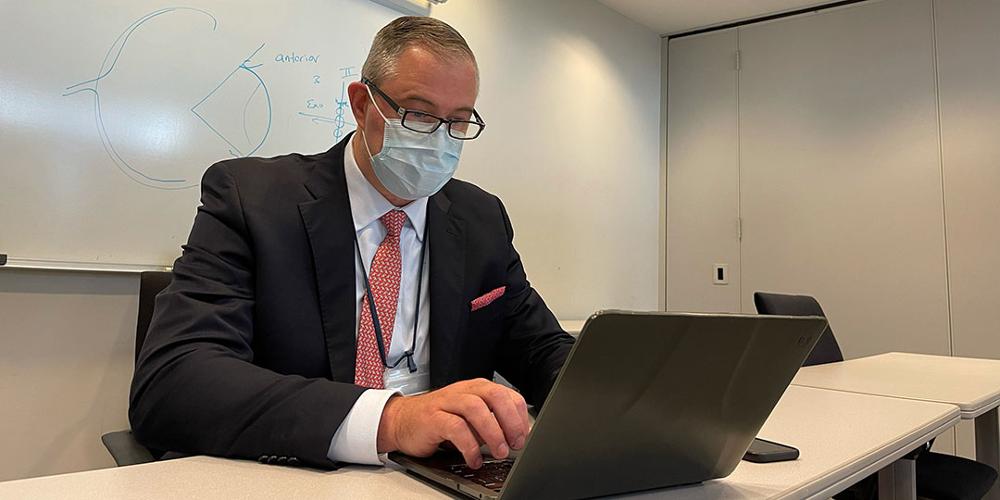Upstate research expenditures grows at higher rate than any in SUNY system; 35 percent increase over five years
During the last fiscal year, Upstate Medical University had record growth in research expenditures – a rate higher than any other campus in the entire SUNY system. Research expenditures grew 11 percent over the previous fiscal year, for a total of nearly $39 million. Research expenditures at Upstate have grown 35 percent during the last five years, which is an especially impressive accomplishment given the ongoing COVID-19 pandemic, said Vice President for Research David C. Amberg, PhD.
In addition to an 11 percent increase in direct expenditures, there was a 10 percent increase in indirect expenditures, which amounts to an additional $1 million in operational money Upstate receives to support the research happening here.
Research growth at Upstate can be attributed to many things, Amberg said, but two notable factors are how researchers spent their time when laboratories were closed at the start of the pandemic and how overall, Upstate faculty are becoming more efficient at applying for funding from a variety of sources.
“Every year we’re seeing more grants being submitted,” he said. “Our faculty isn’t necessarily getting larger. But our research faculty clearly are more successful and more efficient at getting grants.
“And we saw a record number of grant submissions during COVID. The faculty took that time when they couldn’t come in and do experiments in the lab to write papers and to write grants.”
Upstate’s recent success in obtaining more grants has had a snowball effect in that its reputation for being a supportive research environment has created new opportunities for additional funding streams, Amberg said.
“There has also been an increase in our reputation as a research institution,” he said. “It’s our peers who serve on these study sections that review the grants. There’s now recognition that this is a very supportive environment for biomedical research, which plays into how well the grants are scored.”
Upstate has committed to investing in the highest quality research facilities and equipment, as well as expanded Upstate Research support staff, Amberg said. Grant reviewers and their organizations recognize Upstate’s investments and know that its research environment supports success, he said.
Upstate departments that expanded research in the last year include: biochemistry (40 percent increase); urology (38 percent); microbiology (35 percent); pharmacology (21 percent); ophthalmology (18 percent); medicine (18 percent). The top research investigator at Upstate is infectious disease physician-scientist Stephen J. Thomas, MD, credited with $2.2 million in research expenditures. As director of Upstate’s Institute for Global Health & Translational Science, Thomas has significantly expanded the number of clinical trials Upstate offers. Prime examples are the 32 COVID-19-related clinical trials that got off the ground “at record speed,” during the last 16+ months, Amberg said.
Earlier this year, Upstate completed a new strategic plan for research. The 146-page plan sought input from every department and Upstate’s 248 basic and translational research faculty as well as clinical research faculty, Amberg said. The plan seeks to expand “research support structures, capabilities and expertise” during the next five to 10 years. Currently, teams of Upstate research faculty are working on strategies to implement the plan’s priorities, which includes establishing a research-dedicated information technology core and developing a positive incentive strategy for research protected time for clinical faculty, among others.
“Morale in the research community here is better than it’s ever been,” Amberg said. “Before, people were having to put in 10 grants to get one. Now we have many researchers with many large federal grants, which is tremendous.”
When Amberg took the helm of research at Upstate seven years ago, his goal was $40 million in research expenditures. He said given the number of grants submitted by Upstate researchers in the last year, he’s hopeful Upstate will reach that goal in 2022.
“I know our research community. They are my friends,” he said. “I’ve been here 30 years. There probably isn’t a single person, at least in the basic sciences department, that I don’t know by first name; I know what they do and I do care deeply about their success. And whatever I can do to help them, I will.”
Caption: The top research investigator at Upstate is infectious disease physician-scientist Stephen J. Thomas, MD, (pictured above) credited with $2.2 million in research expenditures. As director of Upstate’s Institute for Global Health & Translational Science, Thomas has significantly expanded the number of clinical trials Upstate offers.

